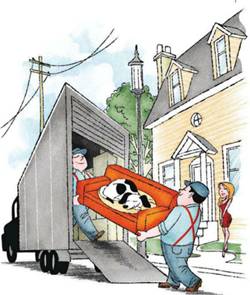Make
your move hassle-free for your pets - and you - with these handy tips.

An estimated 13% of Americans relocate
each year, yet many forget to make plans to help their pet through the transition.
"Animals are often an afterthought during a move," says Katharine
Miller, Ph.D., director of applied science and research for the ASPCA.
"There's risk of him getting forgotten, frightened, lost or injured."
Whether your new address is a few blocks away or across the country, our
information will keep your furry friend protected and happy.
·
Time
Out
During the move, keep your pet out of
harm's way. "Set apart a 'Zen room' where movers won't be and include a
bed, food, water and a litter box," says Miller, "Place a sign on the
door and lock it if you can." If that's not possible, put your cat or dog
in a crate or carrier away from the action, take him to a friend's home or have
him boarded.
·
Identity
Crisis
It's important to keep current contact
information on tags or microchips since pets can slip away unnoticed during the
chaos of moving day or in a new area. Over 60% of stray animals with a
microchip are unable to be returned to their owners due to old materials.
"Microchips are only as good as the registration. If it isn't updated,
then it's as good as not having it," says Kimberly May D.V.M., assistant
director of professional and public affairs at the American Veterinary Medical
Association. Also, both old and new identification labels should remain on
collars until you're in your new place.
·
Poison
Control
Dogs can easily chew through cardboard
boxes and access cleaning products, so put all dangerous items out of reach.
Inspect your new home prior to arrival for poisons or pesticides - check under
stoves and radiators, and block off small spaces where cats may hide and get
stuck. Also walk through the yard to see if there is any harmful vegetation.
The ASPCA's Animal Poison Control Center at aspca.org/pet-care/
poison-control/plants has pictures that can help you identify toxic plants.
·
Settling
In
Make gradual transitions to keep your
pet's stress level low. One way is to get him used to his carrier by setting it
out a few days prior to give him a positive association with moving. When arriving
at your new home, introduce your animal to his surroundings by creating a base
room where he can spend the first few days until he's adjusted, then slowly
give him access to the rest of the house. Before getting him acclimated to the
front yard or backyard, make sure all outdoor space is secured. Strange noises,
smells and sights can easily make him run off, so have pets on a leash when
exploring.
|
Rules
Of The Road
If moving means a
long drive, plan accordingly.
°
Take short practice
trips to get your pet used to the car.
°
Keep the car cool and
well-ventilated to avoid sickness.
°
Some pets need to eat
prior to traveling while others should limit food intake to decrease nausea.
Experiment with both methods before moving.
°
Stop every two to three
hours for bathroom and exercise breaks. Cats and dogs should stay on a leash
at all times, especially at rest stations.
°
Store your animal's
health certificate, proof of vaccinations and vet contact info in an
easy-to-access place.
°
Always keep in the car:
food, cool water, bowls, a favorite toy or blanket, a collar and leash,
disposable litter boxes, prescription medications and a crate or carrier.
|
Paper Trail ª Many
states require documentation for newly relocated dogs and cats, including a
health certificate from your vet verifying that your pet has his required
vaccinations and doesn't have a contagious illness. Contact the state
veterinarian or department of agriculture listed at
usaha.org/portals/6/stateanimalhealthofficials.pdf to find out state
regulations.